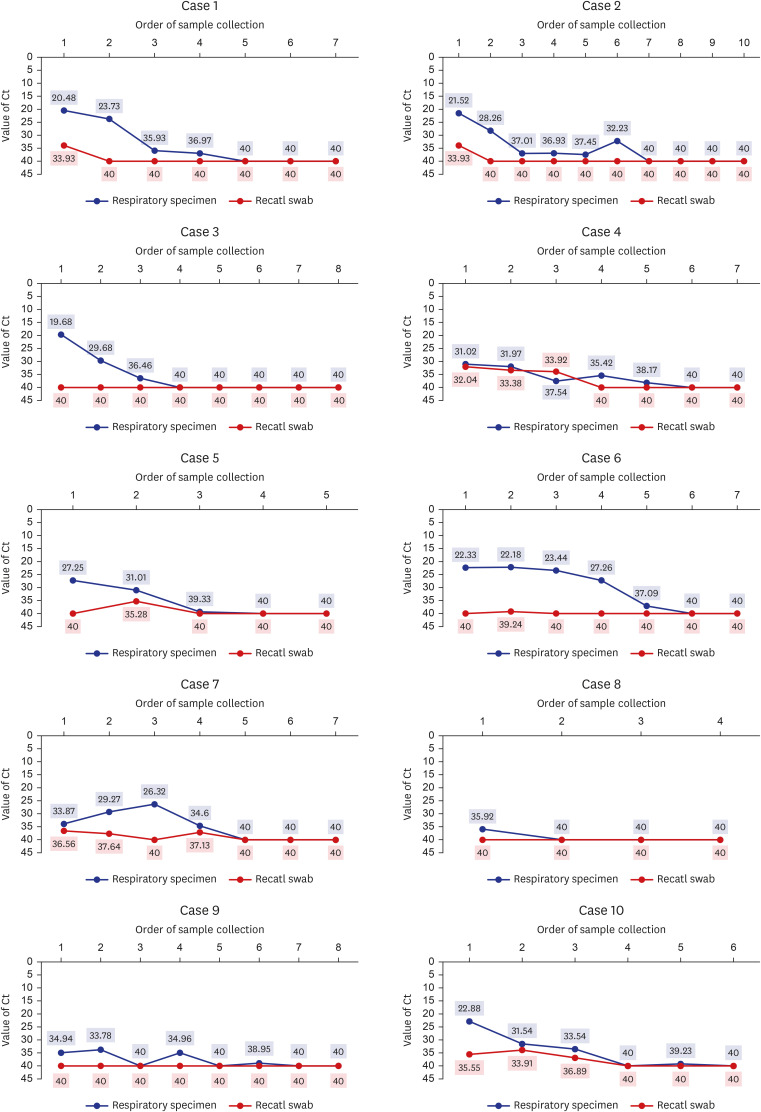J Korean Med Sci.
2021 Nov;36(44):e301. 10.3346/jkms.2021.36.e301.
Serial Screening for SARS-CoV-2 in Rectal Swabs of Symptomatic COVID-19 Patients
- Affiliations
-
- 1Division of Gastroenterology, Department of Internal Medicine, Eunpyeong St. Mary's Hospital, College of Medicine, The Catholic University of Korea, Seoul, Korea
- 2Division of Pulmonary, Critical Care and Sleep Medicine, Department of Internal Medicine, Eunpyeong St. Mary's Hospital, College of Medicine, The Catholic University of Korea, Seoul, Korea
- 3Department of Laboratory Medicine, Eunpyeong St. Mary's Hospital, College of Medicine, The Catholic University of Korea, Seoul, Korea
- KMID: 2522363
- DOI: http://doi.org/10.3346/jkms.2021.36.e301
Abstract
- We used serial rectal swabs to investigate the amount and duration of virus secretion through the gastrointestinal tract and assessed the association between fecal shedding and gastrointestinal symptoms and to clarify the clinical usefulness testing rectal swabs. We enrolled ten adult patients hospitalized with symptomatic coronavirus disease 2019 (COVID-19). Respiratory and stool specimens were collected by physicians. The presence of severe acute respiratory syndrome coronavirus 2 (SARS-CoV-2) was confirmed using real-time reverse-transcription polymerase chain reaction. All ten patients had respiratory symptoms, six had diarrhea, and seven were positive for SARS-CoV-2 on rectal swabs. The viral loads in the respiratory specimens was higher than those in the rectal specimens, and no rectal specimens were positive after the respiratory specimens became negative. There was no association between gastrointestinal symptoms, pneumonia, severity, and rectal viral load. Rectal swabs may play a role in detecting SARS-CoV-2 in individuals with suspected COVID-19, regardless of gastrointestinal symptoms.
Figure
Reference
-
1. Chen N, Zhou M, Dong X, Qu J, Gong F, Han Y, et al. Epidemiological and clinical characteristics of 99 cases of 2019 novel coronavirus pneumonia in Wuhan, China: a descriptive study. Lancet. 2020; 395(10223):507–513. PMID: 32007143.
Article2. Xiao F, Tang M, Zheng X, Liu Y, Li X, Shan H. Evidence for Gastrointestinal Infection of SARS-CoV-2. Gastroenterology. 2020; 158(6):1831–1833.e3. PMID: 32142773.
Article3. D'Amico F, Baumgart DC, Danese S, Peyrin-Biroulet L. Diarrhea during COVID-19 infection: pathogenesis, epidemiology, prevention, and management. Clin Gastroenterol Hepatol. 2020; 18(8):1663–1672. PMID: 32278065.4. Yeo C, Kaushal S, Yeo D. Enteric involvement of coronaviruses: is faecal-oral transmission of SARS-CoV-2 possible? Lancet Gastroenterol Hepatol. 2020; 5(4):335–337. PMID: 32087098.
Article5. Park SK, Lee CW, Park DI, Woo HY, Cheong HS, Shin HC, et al. Detection of SARS-CoV-2 in fecal samples from patients with asymptomatic and mild COVID-19 in Korea. Clin Gastroenterol Hepatol. 2021; 19(7):1387–1394.e2. PMID: 32534042.
Article6. Yoon JG, Yoon J, Song JY, Yoon SY, Lim CS, Seong H, et al. Clinical significance of a high SARS-CoV-2 viral load in the saliva. J Korean Med Sci. 2020; 35(20):e195. PMID: 32449329.
Article7. Kim SE, Lee JY, Lee A, Kim S, Park KH, Jung SI, et al. Viral load kinetics of SARS-CoV-2 infection in saliva in Korean patients: a prospective multi-center comparative study. J Korean Med Sci. 2020; 35(31):e287. PMID: 32776725.
Article8. Lin L, Jiang X, Zhang Z, Huang S, Zhang Z, Fang Z, et al. Gastrointestinal symptoms of 95 cases with SARS-CoV-2 infection. Gut. 2020; 69(6):997–1001. PMID: 32241899.
Article9. Nobel YR, Phipps M, Zucker J, Lebwohl B, Wang TC, Sobieszczyk ME, et al. Gastrointestinal symptoms and coronavirus disease 2019: a case-control study from the United States. Gastroenterology. 2020; 159(1):373–375.e2. PMID: 32294477.10. Redd WD, Zhou JC, Hathorn KE, McCarty TR, Bazarbashi AN, Thompson CC, et al. Prevalence and characteristics of gastrointestinal symptoms in patients with severe acute respiratory syndrome coronavirus 2 infection in the United States: a multicenter cohort study. Gastroenterology. 2020; 159(2):765–767.e2. PMID: 32333911.
Article11. Jang SY, Seon JY, Eun BL, Koh SB, Yoo JH, Lee WY, et al. Risk factors of outcomes of COVID-19 patients in Korea: focus on early symptoms. J Korean Med Sci. 2021; 36(18):e132. PMID: 33975399.
Article12. Zhang W, Du RH, Li B, Zheng XS, Yang XL, Hu B, et al. Molecular and serological investigation of 2019-nCoV infected patients: implication of multiple shedding routes. Emerg Microbes Infect. 2020; 9(1):386–389. PMID: 32065057.
Article13. Nouri-Vaskeh M, Alizadeh L. Fecal transmission in COVID-19: a potential shedding route. J Med Virol. 2020; 92(10):1731–1732. PMID: 32239515.
Article14. Guan WJ, Ni ZY, Hu Y, Liang WH, Ou CQ, He JX, et al. Clinical characteristics of coronavirus disease 2019 in China. N Engl J Med. 2020; 382(18):1708–1720. PMID: 32109013.
Article15. Wang D, Hu B, Hu C, Zhu F, Liu X, Zhang J, et al. Clinical characteristics of 138 hospitalized patients with 2019 novel coronavirus-infected pneumonia in Wuhan, China. JAMA. 2020; 323(11):1061–1069. PMID: 32031570.
Article16. Jin X, Lian JS, Hu JH, Gao J, Zheng L, Zhang YM, et al. Epidemiological, clinical and virological characteristics of 74 cases of coronavirus-infected disease 2019 (COVID-19) with gastrointestinal symptoms. Gut. 2020; 69(6):1002–1009. PMID: 32213556.
- Full Text Links
- Actions
-
Cited
- CITED
-
- Close
- Share
- Similar articles
-
- COVID-19 and Breastfeeding
- The Broad Spectrum of Neuro-Radiological Abnormalities in Patients Infected with SARS-CoV-2 Supports the Diagnosis of Neuro-COVID-19
- SARS-CoV-2-Specific T Cell Responses in Patients with COVID-19 and Unexposed Individuals
- Clinical implications of coronavirus disease 2019 in neonates
- Experiences of Preoperative COVID-19 Screening in Pediatric Patients in a Secondary Care Center


